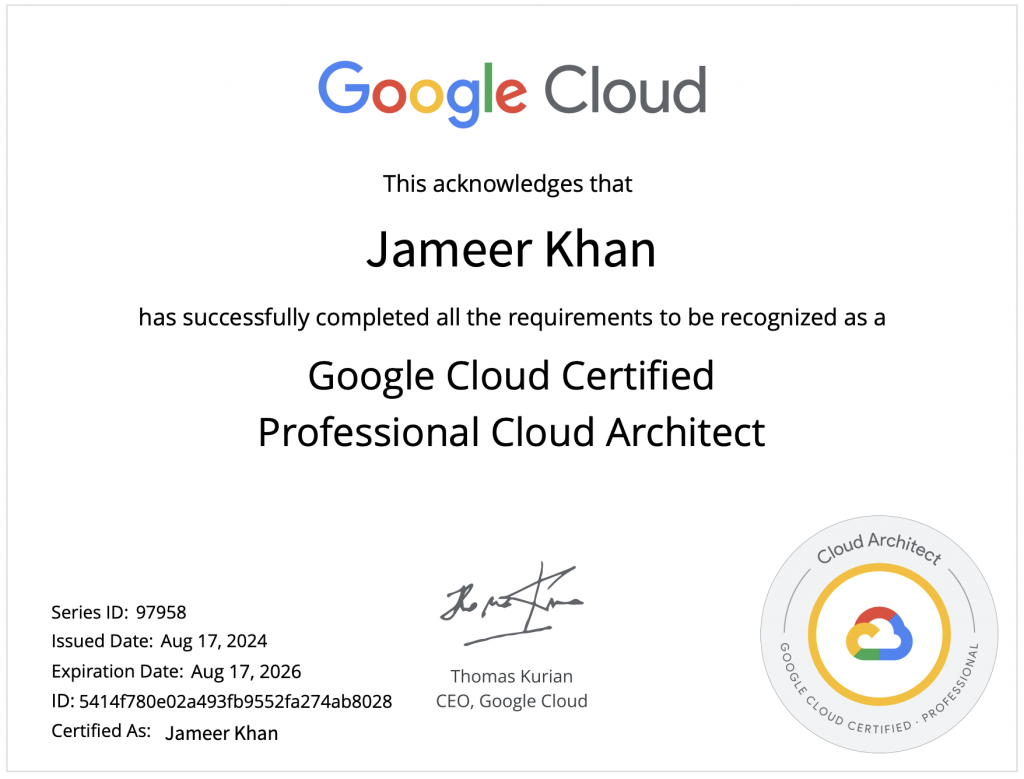I recently appeared for the Google Cloud Professional Cloud Architect exam and fortunately cleared it in the first attempt. I would like to share my journey about exam preparation so it could help someone who will attempt the exam.
GCP PCA is a course offered by Google Cloud for those looking to advance their skills in cloud management. It helps improve cloud system design skills and build a highly performant, reliable, scalable, durable, and cost-efficient solution.
My name is Jameer Khan. I work as a full-stack lead in a company. The company offered me the option of choosing a Google Cloud certification. I chose GCP PCA and started learning about it.
GCP PCA Learning
As a full-stack developer, I have already been exposed to cloud technologies and have worked on various AWS services, such as EC2, S3, Route53, SES, CloudFront, etc. However, I haven’t worked on Google Cloud before.
They provide access to Google Qwiklabs where pre-recorded YouTube videos are created for the complete course. It also has various practice and challenge labs that we can attempt to gain practical exposure.
I started to watch videos, practice labs and explore Google Cloud online documentation. It takes around 2-3 months to complete all these. It includes challenging labs also where you have to complete a given set of tasks in a mocked Google Cloud environment by yourself within a specified time.
GCP PCA Exam Schedule
We scheduled a date for the exam two weeks from now. By that time I have knowledge but not confidence. I thought to attempt mock exams. Researched a bit and figured out that ExamTopics provides bundles of mock exams.
I attempt the first mock exam. I scored 35% which reduced my confidence but I went through all the wrong answers and prepared a list of topics that I needed to cover. I started looking into Google documentation about the topics.
I scored around 50% on my second mock exam and it improved my confidence. I noticed that I have to go through the wrong answers, make a list and explore them in Google documentation.
Each mock set has around 65 questions and each question has 4 answers. Most of the questions are of objective type but some are multi-answer questions.
During initial attempts I could not answer multi-answer questions but day by day it improved and towards the end, I was able to answer multi-answer questions also.
I attempted around 600 questions on ExamTopics. It boosted my confidence so much.
Exam day
On the day of the exam, I cleared my room, cleared the table and joined the exam 10 minutes before. I joined the link and it asks to complete certain prerequisites like capturing a picture, providing government ID proof, sharing pictures of room walls etc.
After completion, a support person joins where he asks to show the room on a video call by moving the laptop slowly. He also asks to show the surroundings of the table.
All the prerequisites took almost half an hour and the exam finally started. However, even after spending half an hour in the setup, I got two hours for the exam.
The Exam
The exam went well, first 10 questions were based on case studies- Mountkirk Games and TerramEarth.
I completed the exam within an hour and I was left with one additional hour. I spent the remaining time to review the answers.
I submit the exam where it asks for a survey to do and I click skip. Right after that, it shows status as “Pass”.
I captured a picture of that and closed the system. They provide the status as “Pass” or “Fail”. They do not provide any score or marks.
Two days later, I received an email from Credly to claim the Google Cloud certification and here it is.

GCP PCA Study Materials
There are so many study resources available online to prepare for the Google Cloud Professional Cloud Architect exam. Here are some resources that I used during my preparation.
- Qwiklabs: provides comprehensive study material in the form of documents and videos.
Qwiklabs – Google Cloud Skills Boost - SkillCertPro: provides various mock exam sets.
SkillCertPro – GCP PCA Practice Exam - ExamTopics: provides some mock exam questions for free.
ExamTopics – Google Cloud Professional Cloud Architect - Google Cloud Docs: I use it to explore the topics where I have doubts.
Example: Google Cloud VPN Concepts - YouTube: provides detailed explanations to Google Case study questions.
Bonus
I prepared rough notes during preparation. I would love to share it with you. Comment below if you have any questions.
My GCP Architect Notes

